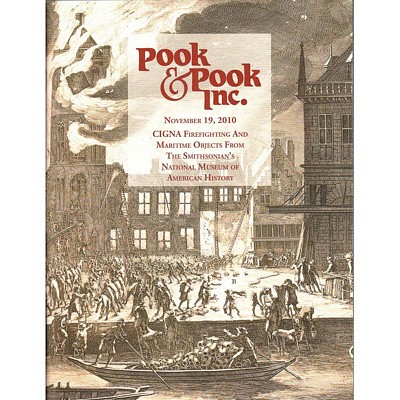Realized Total: $664,000, 100% sold, 383 lots CIGNA Firefighting and Maritimes Objects from the Smithsonian's National Museum of American History: In 2004, the Smithsonian Institution received a remarkable offer from the CIGNA Corporation in Philadelphia. CIGNA proposed the donation of its extraordinary collection of historic firefighting and maritime artifacts to the National Museum of American History. As the nation’s oldest fire and marine insurance company, CIGNA’s predecessor, the Insurance Company of North America (INA), had amassed several thousand historic objects and materials dating as far back as 1792. These ranged from pieces of water mains and sections of fire hoses of all periods to actual fire engines, marine paintings, prints, and ship models. The company also saved extensive business materials from its past, including street signs, commemorative silverware, boardroom tables, and souvenirs. *The Smithsonian has had a long-standing association with the CIGNA Museum and Art Collection. The INA loaned portions of its collections to the Smithsonian’s National Museum (as it was then known) as far back as 1939, for display in the Arts and Industries Building on the National Mall in Washington, D.C. When the National Museum of American History opened in January 1964 (as the National Museum of History and Technology), the INA loaned more of its historic maritime and firefighting collections to help fill the Museum’s halls. Coincidentally, the Museum displayed these artifacts in the area that became the Hall of American Maritime Enterprise. Once again, in 1978, the INA stepped forward and provided support and content for a re-creation of a 19th-century insurance underwriter’s office in the center of the maritime exhibition, which remained until the Museum’s 2006 closure for extensive renovation. The Museum finished a two-year, $85 million renovation of the building’s center core in November 2008, completely transforming its architectural appeal while reorganizing and renewing the presentation of its extensive collections. One of the new exhibitions, On the Water, is dedicated to maritime America and contains CIGNA collection items. *In 2004 CIGNA charted a new course, and its administration decided that the art and history collections were no longer a central part of the corporate mission. The company donated significant regional materials to local history organizations and museums, but reserved the bulk of its holdings for an unrestricted gift to the Smithsonian, as the institution most capable of handling such a large and diverse collection. CIGNA also provided a generous financial donation to the Museum to process the thousands of incoming objects. *For more than a year before the Museum closed in 2006, staff processed the CIGNA collections in a public exhibit gallery, thus sharing the excitement of opening huge crates and removing and documenting the extensive holdings as they came in truckloads from CIGNA’s Philadelphia headquarters. Named FIRE AND WATER: The CIGNA Firefighting and Maritime Collection, this exhibit was extremely popular with our visitors, as it provided a rare behind-the-scenes glimpse of how the Museum acquires and processes its collections. *Items were first distributed to the Museum’s maritime history and community life collections, and then among its other collecting units such as graphic arts, military history, textiles, and political history. As the unpacking and processing continued, it became apparent that the Museum already had examples of many of the artifacts. For example, the Museum’s collections included two fine scale ship models of USS Constitution, better known as Old Ironsides—one of the original six frigates in the U.S. Navy. CIGNA’s marine collection included an additional four Constitution models. These duplicates were not added to the Museum’s collections but put aside for future distribution, along with objects that did not fit within the Museum’s mission. Then the Museum transferred objects to other Smithsonian museums. For example, early aviation prints, airplane models, and portraits went to the National Air and Space Museum, the National Portrait Gallery, and the Smithsonian American Art Museum. *At the same time, CIGNA or INA converted several existing decades-old loans to fire museums around the nation into donations, reflecting CIGNA’s tradition of generosity and its long-term desire to share this unique heritage with the American public. In the same spirit, the National Museum of American History offered fire museums across the country an opportunity to acquire unaccessioned material from the CIGNA collection, resulting in the transfer of more than 130 firefighting objects. *The material consigned here has not been accessioned and has never been part of the Smithsonian’s collections. In accordance with Smithsonian policies and general museum standards, all proceeds from this auction will go into a dedicated fund for the purchase of objects to strengthen and augment the Museum’s existing collections. *Most of the CIGNA Museum and Art Collection objects remain at the Smithsonian; some of them are already on display. Millions of visitors now enjoy these remarkable artifacts and learn about their significant role in shaping American history. *Brent D. Glass, Director, National Museum of American History Smithsonian Institution, Washington, DC. *The Smithsonian’s National Museum of American History is responsible for the collection, care, and preservation of more than three million objects. The collections represent the nation’s heritage in the areas of science, technology, industry, politics, social life, and culture. The collections include first ladies’ gowns, a Samuel Morse telegraph, locomotives, tools, Dorothy’s ruby slippers, an Alexander Graham Bell telephone, flags, American-made quilts, Muhammad Ali’s boxing gloves, Duke Ellington’s sheet music, and presidential artifacts. For more information, visit the Museum’s website at http://americanhistory.si.edu 18.5%bp
 Estimate$200 - $300
Estimate$200 - $300 Estimate$200 - $400
Estimate$200 - $400 Estimate$200 - $400
Estimate$200 - $400 Estimate$500 - $1,000
Estimate$500 - $1,000 Estimate$1,000 - $1,500
Estimate$1,000 - $1,500 Estimate$1,000 - $1,500
Estimate$1,000 - $1,500 Estimate$1,000 - $2,000
Estimate$1,000 - $2,000 Estimate$300 - $400
Estimate$300 - $400 Estimate$300 - $500
Estimate$300 - $500 Estimate$300 - $500
Estimate$300 - $500 Estimate$300 - $500
Estimate$300 - $500 Estimate$300 - $500
Estimate$300 - $500 Estimate$300 - $500
Estimate$300 - $500 Estimate$300 - $500
Estimate$300 - $500 Estimate$800 - $1,200
Estimate$800 - $1,200 Estimate$200 - $400
Estimate$200 - $400 Estimate$400 - $600
Estimate$400 - $600 Estimate$200 - $400
Estimate$200 - $400 Estimate$200 - $400
Estimate$200 - $400 Estimate$800 - $1,000
Estimate$800 - $1,000 Estimate$300 - $400
Estimate$300 - $400 Estimate$200 - $400
Estimate$200 - $400 Estimate$500 - $800
Estimate$500 - $800 Estimate$400 - $700
Estimate$400 - $700 Estimate$400 - $600
Estimate$400 - $600 Estimate$800 - $1,200
Estimate$800 - $1,200 Estimate$800 - $1,200
Estimate$800 - $1,200 Estimate$500 - $1,000
Estimate$500 - $1,000 Estimate$400 - $700
Estimate$400 - $700 Estimate$200 - $400
Estimate$200 - $400 Estimate$2,000 - $3,000
Estimate$2,000 - $3,000 Estimate$400 - $600
Estimate$400 - $600 Estimate$200 - $400
Estimate$200 - $400 Estimate$1,000 - $1,500
Estimate$1,000 - $1,500 Estimate$300 - $500
Estimate$300 - $500 Estimate$200 - $400
Estimate$200 - $400 Estimate$1,000 - $1,500
Estimate$1,000 - $1,500 Estimate$1,500 - $2,000
Estimate$1,500 - $2,000 Estimate$1,000 - $1,500
Estimate$1,000 - $1,500 Estimate$500 - $1,000
Estimate$500 - $1,000 Estimate$200 - $400
Estimate$200 - $400 Estimate$300 - $500
Estimate$300 - $500 Estimate$1,000 - $1,500
Estimate$1,000 - $1,500 Estimate$200 - $400
Estimate$200 - $400 Estimate$200 - $400
Estimate$200 - $400 Estimate$1,000 - $1,500
Estimate$1,000 - $1,500 Estimate$50 - $100
Estimate$50 - $100



 EUR
EUR CAD
CAD AUD
AUD GBP
GBP MXN
MXN HKD
HKD CNY
CNY MYR
MYR SEK
SEK SGD
SGD CHF
CHF THB
THB












 Live Auction in Progress
Live Auction in Progress